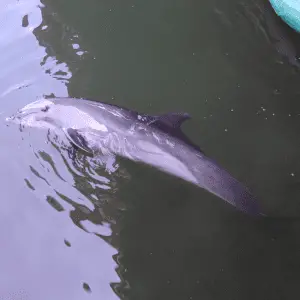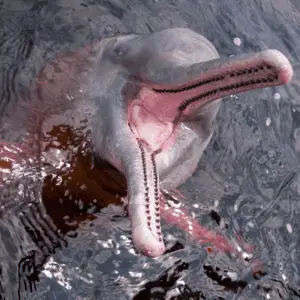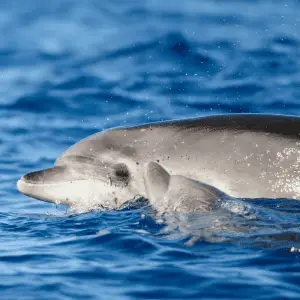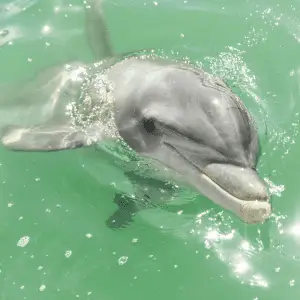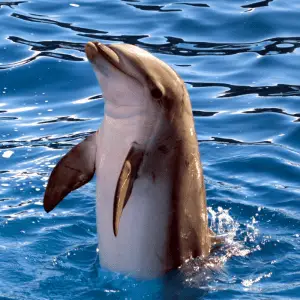Dolphins fascinate me. Since I first saw them in their natural habitat, I have been obsessed with them. They are so graceful in the water.
They are one of the most amazing creatures on this planet.
After reading the facts below, I think you will agree with me!
- Dolphins can not smell underwater or above the water’s surface, as they are missing the complete olfactory organ with all the nerves. Without this organ in its entirety, it’s impossible for a dolphin or any other animal to have any sense of smell.
- Dolphins can swim faster than sharks because dolphins are shaped like a tube, which helps them swim faster. Sharks are fast too, but in most cases, because of their body shape, dolphins get the advantage.
- The hearing range of dolphins is more extensive than most other living species. Dolphins can hear sounds underwater and above the water. Dolphins communicate with each other using complex techniques known as sonar and echolocation; this also helps them to hunt and navigate.
- Dolphins can see in the dark. Dolphins can see much better underwater than humans. The lens and cornea that the dolphins have in their eyes enable them to have accurate vision both inside the water and out. The unique thing is the dolphins also have rods and cones cells in their retinas. The rod and the cone cells are responsible for clear vision in bright and dim light. The dolphins have these cells in the retina to see in both situations.
- Dolphins communicate mainly through sound, but they also use several nonverbal gestures to express their thoughts and feelings to other pod members or other species. The dolphins also make physical contact with other dolphins to communicate.
- Dolphins’ belly turns pink because they expel excessive heat through this region. The process is called vasodilation, in which the blood vessels will be widened to expel the heat, thus showing off a pinkish colour. It happens mainly in the summer months when the water temperature is high. However, it can also occur when a dolphin blushes. Like us humans, they also have this emotion that turns the belly pink.
- Dolphins have more than one mate. Dolphins are polygamous animals, so they do not mate for life. But they can make long-lasting relationships with other dolphins in their group.
- Even though dolphins are aquatic animals, they are not fish. Instead, the dolphins are mammals, and the males and females are called bulls, and cows like so many other mammals are.
- The baby dolphins are known as calves. After birth, the babies become entirely dependent on their mothers’ milk. Milking is the most blatant proof that dolphins are mammals and not fishes.
- Dolphins do not lay eggs. They are aquatic mammals, and just like most other mammals, dolphins give birth to their babies live.
- Dolphins can’t survive on land because their bodies have evolved to live underwater. If they don’t stay in the water, they will die. Also, their limbs won’t support them when they go onto land, and their skin will become dehydrated and damaged from the sun. They also need the diet of fish and other sea creatures found in the water to survive.
- Baby dolphins are dependent on their mother’s milk. The mother dolphin feeds her baby from the minute they are born. Calves will drink milk until they are 2-3 years old, but they eat a little bit of fish from 4-5 months old. As the dolphin babies get older, they eat more meat. But they need to learn to hunt before they can be weened of entirely from their mother’s milk.
- Dolphins do not chew their food. Their teeth are not designed for chewing. Instead, they have a special compartment in their stomach that helps them grind down their food. If the prey is too large to swallow whole, dolphins will shake or rub it on the ocean floor until small pieces break off of the prey so that they can eat it.
- You can’t milk dolphins in the traditional sense. Experts can still collect or gather milk from dolphins. Even though you can technically milk all mammals, the problem with the dolphins is that the mother controls the milk flow, and the nipples are hidden away in the mammary slits.
- Dolphins have two stomachs, split into three different gastric compartments within. These three stomach chambers all have different digestive processes from each other and are connected using tiny tubes.
- There are 42 species of dolphin. They all have different features that make them different from each other. Some species live in saltwater, and some live in freshwater.
- The average lifespan of dolphins is 25 to 35 years. However, the lifespan of a dolphin varies depending on the species. For example, the orcas can live for more than 90 years. The lifespan of bottlenose dolphins is about 30 to 50 years. The lifespan of the dolphins living in captivity can vary depending on their health and living conditions.
- Female dolphins have nipples tucked up inside two folds of skin called mammary slits. This structure opens, and the nipples come out when it is required. Whenever the dolphin calves are ready to feed, they nudge on the mammary slits of their mother to alert her they need feeding.
- Dolphins sleep underwater. However, they can’t breathe underwater, so they need to come up for air every once in a while. This kind of sleeping is called unihemispheric slow-wave sleep (USWS), which means that half the brain stays awake whilst a dolphin sleeps to come up for air when needed.
- Dolphins are very intelligent and are one of the most intelligent animals in the world. Dolphins showcase many complex things, like showing sorrow or happiness, awareness of themselves, high problem-solving skills, emotional empathy and playfulness.
- Dolphins are wild animals. Dolphins do not like being around people or kissing them. So they do not kiss people voluntarily. In dolphin shows, they kiss people because they have to. None of this is a natural behaviour. Every dolphin that is captive and exhibits this kind of behaviour has been trained over a long period to perform this behaviour correctly.
- A dolphin’s eyes can move independently to each other, which gives them a clear view of around them.
- If the dolphin’s teeth get damaged or removed, they will not grow back. But each year, dolphins get a thin layer of tooth added to an existing tooth. If you dissect their tooth and count these layers, you can estimate how old they are.



